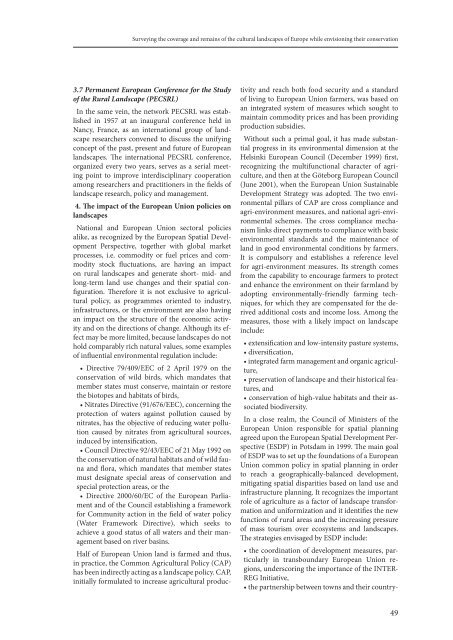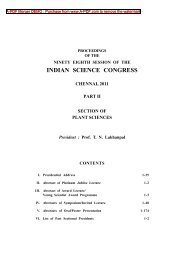sustainable use of biological diversity.pdf - India Environment Portal
sustainable use of biological diversity.pdf - India Environment Portal
sustainable use of biological diversity.pdf - India Environment Portal
You also want an ePaper? Increase the reach of your titles
YUMPU automatically turns print PDFs into web optimized ePapers that Google loves.
Surveying the coverage and remains <strong>of</strong> the cultural landscapes <strong>of</strong> Europe while envisioning their conservation<br />
3.7 Permanent European Conference for the Study<br />
<strong>of</strong> the Rural Landscape (PECSRL)<br />
In the same vein, the network PECSRL was established<br />
in 1957 at an inaugural conference held in<br />
Nancy, France, as an international group <strong>of</strong> landscape<br />
researchers convened to discuss the unifying<br />
concept <strong>of</strong> the past, present and future <strong>of</strong> European<br />
landscapes. The international PECSRL conference,<br />
organized every two years, serves as a serial meeting<br />
point to improve interdisciplinary cooperation<br />
among researchers and practitioners in the fields <strong>of</strong><br />
landscape research, policy and management.<br />
4. The impact <strong>of</strong> the european union policies on<br />
landscapes<br />
National and European Union sectoral policies<br />
alike, as recognized by the European Spatial Development<br />
Perspective, together with global market<br />
processes, i.e. commodity or fuel prices and commodity<br />
stock fluctuations, are having an impact<br />
on rural landscapes and generate short- mid- and<br />
long-term land <strong>use</strong> changes and their spatial configuration.<br />
Therefore it is not exclusive to agricultural<br />
policy, as programmes oriented to industry,<br />
infrastructures, or the environment are also having<br />
an impact on the structure <strong>of</strong> the economic activity<br />
and on the directions <strong>of</strong> change. Although its effect<br />
may be more limited, beca<strong>use</strong> landscapes do not<br />
hold comparably rich natural values, some examples<br />
<strong>of</strong> influential environmental regulation include:<br />
• Directive 79/409/EEC <strong>of</strong> 2 April 1979 on the<br />
conservation <strong>of</strong> wild birds, which mandates that<br />
member states must conserve, maintain or restore<br />
the biotopes and habitats <strong>of</strong> birds,<br />
• Nitrates Directive (91/676/EEC), concerning the<br />
protection <strong>of</strong> waters against pollution ca<strong>use</strong>d by<br />
nitrates, has the objective <strong>of</strong> reducing water pollution<br />
ca<strong>use</strong>d by nitrates from agricultural sources,<br />
induced by intensification,<br />
• Council Directive 92/43/EEC <strong>of</strong> 21 May 1992 on<br />
the conservation <strong>of</strong> natural habitats and <strong>of</strong> wild fauna<br />
and flora, which mandates that member states<br />
must designate special areas <strong>of</strong> conservation and<br />
special protection areas, or the<br />
• Directive 2000/60/EC <strong>of</strong> the European Parliament<br />
and <strong>of</strong> the Council establishing a framework<br />
for Community action in the field <strong>of</strong> water policy<br />
(Water Framework Directive), which seeks to<br />
achieve a good status <strong>of</strong> all waters and their management<br />
based on river basins.<br />
Half <strong>of</strong> European Union land is farmed and thus,<br />
in practice, the Common Agricultural Policy (CAP)<br />
has been indirectly acting as a landscape policy. CAP,<br />
initially formulated to increase agricultural productivity<br />
and reach both food security and a standard<br />
<strong>of</strong> living to European Union farmers, was based on<br />
an integrated system <strong>of</strong> measures which sought to<br />
maintain commodity prices and has been providing<br />
production subsidies.<br />
Without such a primal goal, it has made substantial<br />
progress in its environmental dimension at the<br />
Helsinki European Council (December 1999) first,<br />
recognizing the multifunctional character <strong>of</strong> agriculture,<br />
and then at the Göteborg European Council<br />
(June 2001), when the European Union Sustainable<br />
Development Strategy was adopted. The two environmental<br />
pillars <strong>of</strong> CAP are cross compliance and<br />
agri-environment measures, and national agri-environmental<br />
schemes. The cross compliance mechanism<br />
links direct payments to compliance with basic<br />
environmental standards and the maintenance <strong>of</strong><br />
land in good environmental conditions by farmers.<br />
It is compulsory and establishes a reference level<br />
for agri-environment measures. Its strength comes<br />
from the capability to encourage farmers to protect<br />
and enhance the environment on their farmland by<br />
adopting environmentally-friendly farming techniques,<br />
for which they are compensated for the derived<br />
additional costs and income loss. Among the<br />
measures, those with a likely impact on landscape<br />
include:<br />
• extensification and low-intensity pasture systems,<br />
• diversification,<br />
• integrated farm management and organic agriculture,<br />
• preservation <strong>of</strong> landscape and their historical features,<br />
and<br />
• conservation <strong>of</strong> high-value habitats and their associated<br />
bio<strong>diversity</strong>.<br />
In a close realm, the Council <strong>of</strong> Ministers <strong>of</strong> the<br />
European Union responsible for spatial planning<br />
agreed upon the European Spatial Development Perspective<br />
(ESDP) in Potsdam in 1999. The main goal<br />
<strong>of</strong> ESDP was to set up the foundations <strong>of</strong> a European<br />
Union common policy in spatial planning in order<br />
to reach a geographically-balanced development,<br />
mitigating spatial disparities based on land <strong>use</strong> and<br />
infrastructure planning. It recognizes the important<br />
role <strong>of</strong> agriculture as a factor <strong>of</strong> landscape transformation<br />
and uniformization and it identifies the new<br />
functions <strong>of</strong> rural areas and the increasing pressure<br />
<strong>of</strong> mass tourism over ecosystems and landscapes.<br />
The strategies envisaged by ESDP include:<br />
• the coordination <strong>of</strong> development measures, particularly<br />
in transboundary European Union regions,<br />
underscoring the importance <strong>of</strong> the INTER-<br />
REG Initiative,<br />
• the partnership between towns and their country-<br />
49
















